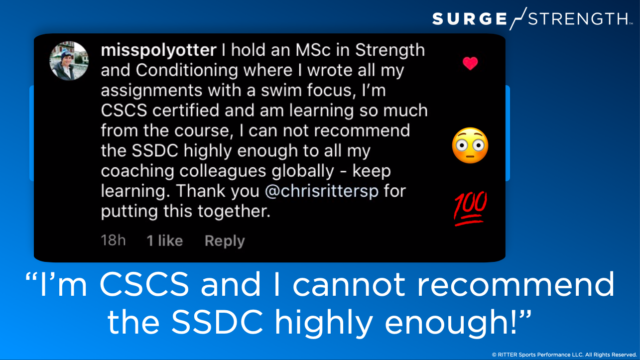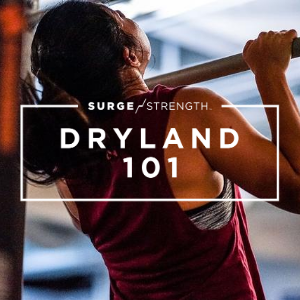If 2020 has shown anything, it’s the importance of having a “go-to” bodyweight dryland workout. More people than ever are working out from home. With various COVID restrictions around the country, many people are stuck at home or unable to safely use equipment in public training spaces. Therefore, SURGE Strength has created a list of our favorite, go-to bodyweight exercises for your next dryland workout.
Your Bodyweight Dryland Workout Can Include:
- Warm-up
- Squats
- Hinges
- Pull-ups
- Push-ups
- Planks
- Hollow Body Hold
- Shoulder Pre-hab
- Plyometrics
- Swim-Specific Drills
- Breathing Drills
In this article, we’ll explore variations of each exercise listed, along with demo videos that will help you follow along. Let’s get up and get moving!
Warm-Up for your bodyweight dryland workout
As always, be sure to properly warm-up before trying any of the core recommended exercises. A good indication that you are “warm” is simply by breaking a sweat. Sufficient warm-ups get the blood flowing and allow your body to gradually ramp up its intensity in the safest way possible.
Have some space to move around? Try our locomotive warm-up:
Stuck inside without much room? Try our static warm-up:
1) Squats in your bodyweight dryland workout
Squats are essential exercises for swimming. Every time you push off the wall, you are performing a squat. In addition, squats build leg strength required for a solid kick. Squats are an extremely versatile exercise that can be changed a lot depending on your current needs. For example, you can load your squats by holding a heavy object (such as a packed swim bag). You can try adding a jump to your squat to train power. Then, you can intensify a tempo such as a slow, eccentric lowering phase to your squat with a hold at the bottom. Then, explode up. Change it up and opt for a single leg squat. All of these variations will challenge your body in slightly different ways that yield results when it’s time to hop back in the pool.
Are you squatting with proper form?
2) Hinges in your bodyweight dryland workout
Hinges are different than squats because most of the movement is coming from the hip joint as opposed to the knee joint. These are important for building a strong posterior chain all the way from your hamstrings to your upper back. Swimmers especially benefit from hinging because of their natural forward head posture induced by repetitive overhead motion.
Most hinges, like deadlifts and RDL’s, are performed standing. Try this hip hinging drill to activate your posterior chain and enforce better posture. You will also feel a stretch in the hamstrings. Hug your packed swim bag to your chest if you really want to work.
- RDL: Romanian Deadlift
Not a fan of traditional hinges? No worries. There are other hinge variations we love such as glute bridges: these are accomplished on the floor or off of a bench. A weighted object can be added to the hips or you can simply lift a leg to challenge yourself.
3) Pull-Ups in your bodyweight dryland workout
Pull-ups are a great way to increase your pull strength. Your body will provide plenty of resistance as you squeeze your lats to pull your chin to the bar. If you have a pull-up bar at home, make sure it is safely secured. Otherwise, look for a pull-up bar next time you are at a park or playground.
If you can’t do a pull-up quite yet, opt for a flexed arm hang. Simply time yourself hanging from the bar and release down slowly as shown in the video below.
4) Push-Ups in your bodyweight dryland workout
Push-ups are another great bodyweight exercise that strengthen your chest, shoulders, and core, resulting in stronger strokes in the water. Our favorite push-up variation is the “hands up” pushup. In this variation, you lift your hands up off the floor at the bottom of the push-up. By doing so, your hands naturally fall in the perfect power position to drive up out of the push-up. Protect your shoulders from bad form and ensure depth as you come all the way to the ground in this push-up. Lastly, train your core as you push up off the ground in a straight line. You might be surprised by how good this one feels!
5) Planks in your bodyweight dryland workout
Planks are a simple and effective way to challenging your core strength. Plus, there are many different variations to try. Many people plank on their front (either on their hands or elbows) or on their sides. But, did you know that you can do a plank on your back? That’s right, and your back is included as part of your core, which many people forget. Try this one out.
6) Hollow Body Holds in your bodyweight dryland workout
Another core exercise we love are hollow body holds. This movement is perfect for swimmers since it mimics a strong streamline position. The key to this movement is bracing your entire core by pressing your back into the floor and shaping your body to look like a boat or banana. But don’t worry coaches, it’s much harder than it looks.
7) Shoulder Pre-hab in your bodyweight dryland workout
Pre-hab stands for pre-habilitation. These exercises are intended to prevent injuries rather than rehabbing them after the injury occurs. Since shoulder injuries are very prevalent in swimming, we wanted to share two of our favorite body weight shoulder pre-hab exercises: seated wall angels and shoulder wall rotations.
Wall angels are another exercise that can be harder than it looks. The challenge here is to keep your wrists on the wall, while maintaining a good posture. These work the rotator cuff muscles while mobilizing the upper body. Try them seated with legs out straight to get a nice lower body stretch at the same time.
Shoulder wall rotations are another great way to strengthen the muscles around the shoulder joint while opening the chest and mid-back. Be mindful throughout this exercise and hold the stretch along the wall where you feel most tight for some extra mobility.
8) Plyometrics in your bodyweight dryland workout
Plyometrics increase power. When trained properly, they give swimmers a strong start and powerful turns. There are many body weight plyometrics out there. We recommend keeping it simple with pogo jumps. Pogo jumps mimic the action of the lower legs off of every wall and strengthen the ankle joints. This is very important, especially for a sport that’s performed completely barefoot.
Below, we pair pogo jumps with a broad jump for a fun variation that challenges both ankle strength (in the pogo jumps) and hip drive (in the broad jump). Try it out and tag us on in your story on Instagram, @surge.strength. We’ll repost you!
9) Swim-Specific Drills in your bodyweight dryland workout
Worried about losing your stroke mechanics while pools are shut down? Now, you can check on your swim position straight from your living room with these swim specific drills. Training these exercises on land gives you more feedback than moving blindly through the water.
Grab a broomstick and try this one out for the catch position:
See what your streamline really looks like with this swim-specific bodyweight drill:
10) Breathing Drills in your bodyweight dryland workout
While swimming, it’s important not to hold your breath while swimming. Swimmers are constantly blowing air out and working on taking the perfect breath in as they take a stroke. That’s why it’s important to also train your breath during dryland.
Bodyweight sessions at home are the perfect time to check in with your breathing. You should not hold your breath during dryland workouts, just like you shouldn’t hold your breath underwater. In a perfect world, you’re looking for a long breath in and a long breath out. This video exercise below teaches you to brace your core and breathe at the same time.
- Learn More: BETTER CORE TRAINING IS JUST A BREATH AWAY
Imagine how much longer and harder you can work at an exercise bout when you breathe and brace simultaneously:
We hope that trying these exercises has you feeling motivated to train even during canceled swim seasons and quarantines. While this is a comprehensive list of movements, it is not an individualized fitness plan. In order to maximize your results, consider working with one of our Dryland Certified Coaches to get a customized dryland program for you and your goals.
Another option is to become an expert in dryland programming by becoming SURGE Strength Dryland Certified (SSDC).
Most importantly though, stay consistent in your training. If you’re not actively progressing forward, you are moving backwards. In other words, something is almost always better than nothing. Even if you are not able to maintain a periodized weight training plan this season, you can stay powerful, strong, athletic, and healthy with these bodyweight exercises. At the end of your workout, take a sweaty selfie and tag @surge.strength on Instagram.
And remember, better athletes make faster swimmers.
JOIN OTHERS FROM AROUND THE WORLD THAT ARE
BECOMING SURGE STRENGTH DRYLAND CERTIFIED (SSDC)

ENROLL NOW FOR FREE IN THE SURGE STRENGTH ACADEMY
BECOME SURGE STRENGTH DRYLAND CERTIFIED (SSDC)
BUILD BETTER ATHLETES TO GENERATE FASTER SWIMMERS
Courtesy of SwimSwam’s exclusive dryland training partner, SURGE Strength.
SURGE Strength, a strength training brand created by Chris Ritter, CEO of RITTER Sports Performance, aims to build better athletes and faster swimmers through dryland programs, and coaching education.






